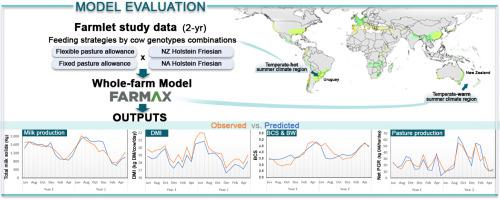Agricultural Systems ( IF 6.6 ) Pub Date : 2021-07-21 , DOI: 10.1016/j.agsy.2021.103227 Sofía Stirling 1 , Santiago Fariña 1 , David Pacheco 2 , Ronaldo Vibart 2

|
CONTEXT
Modelling grazing dairy systems from the temperate hot-summer climate region of South America is challenging due to the absence of suitable whole-farm models developed or evaluated in this region. The use of whole-farm models developed in other regions represents an opportunity. However, the accuracy and precision of their predictions need to be assessed.
OBJECTIVES
The present study evaluated the predictive ability of Farmax Dairy Pro, a whole-farm model developed in New Zealand, to simulate grazing dairy systems in Uruguay.
METHODS
Data used for the model evaluation was obtained from a dairy farmlet study carried out in Uruguay. The study aimed to explore four intensification strategies based on increasing home-grown forage utilisation and milk output per hectare. The field experiment consisted of four farmlets using two feeding strategies: [Grass Maximum (GMAX) and Grass Fixed (GFIX), based on the amount of grazed herbage in the diet], and two cow genotypes [New Zealand (NZHF) or North American Holstein-Friesian (NAHF)]. The four farmlets were modelled with Farmax for two consecutive years. Model evaluation was performed using standard regression, dimensionless and error index statistics. The model was evaluated by comparing predicted versus observed monthly patterns of milk, milk fat, milk protein and milk solids (MS; milk fat + milk protein) yields, body condition score (BCS), body weight (BW), DM intake (DMI) and net pasture growth rate (PGR). An application of the model was demonstrated by modelling three scenarios for the GMAX-NZHF farmlet.
RESULTS AND CONCLUSIONS
The predictive ability of Farmax was similar for the four farmlets modelled, including patterns over time, for all the variables evaluated. The model provided a robust prediction for monthly patterns of milk and milk components yields at a herd level for total DMI and PGR. The model had a moderate ability to predict monthly patterns of individual milk and milk components yields and BCS, and a poor ability to predict BW. The scenario modelling results indicate that the model could be used with confidence to simulate different farm system alternatives. Overall, the Farmax Dairy Pro model had the potential to provide adequate predictions for grazing dairy systems from Uruguay.
SIGNIFICANCE
This model will allow the exploration of future intensification pathways for grazing dairy systems in Uruguay and the region, including changes in the forage sequence, stocking rate and calving season. Further adjustments of the model will expand the range of systems and latitudes for this model to be utilised.
中文翻译:

乌拉圭放牧奶牛系统的全农场建模
语境
由于缺乏在该地区开发或评估的合适的全农场模型,对南美洲温带夏季气候地区的放牧奶牛系统进行建模具有挑战性。使用其他地区开发的全农场模式代表了一个机会。但是,需要评估他们预测的准确性和精确度。
目标
本研究评估了 Farmax Dairy Pro 的预测能力,这是一种在新西兰开发的全农场模型,用于模拟乌拉圭的放牧乳品系统。
方法
用于模型评估的数据来自在乌拉圭进行的奶牛场研究。该研究旨在探索基于增加本土饲草利用率和每公顷牛奶产量的四种集约化策略。田间试验包括使用两种饲喂策略的四个农场:[最大牧草 (GMAX) 和固定牧草 (GFIX),基于饮食中放牧的牧草量],以及两种奶牛基因型 [新西兰 (NZHF) 或北美荷斯坦-弗里斯兰 (NAHF)]。四个农场连续两年使用 Farmax 建模。使用标准回归、无量纲和误差指数统计进行模型评估。该模型通过比较预测与观察到的每月牛奶、乳脂、乳蛋白和乳固体(MS;乳脂 + 乳蛋白)产量模式进行评估,体况评分 (BCS)、体重 (BW)、干物质摄入量 (DMI) 和净牧场增长率 (PGR)。通过对 GMAX-NZHF 农场的三个场景建模,展示了该模型的应用。
结果和结论
对于所有评估的变量,Farmax 对建模的四个农场的预测能力相似,包括随时间变化的模式。该模型为总 DMI 和 PGR 的牛群水平的每月牛奶和牛奶成分产量模式提供了可靠的预测。该模型预测单个牛奶和牛奶成分产量和 BCS 的月度模式的能力中等,而预测 BW 的能力较差。情景建模结果表明,该模型可用于模拟不同的农场系统替代方案。总体而言,Farmax Dairy Pro 模型有可能为乌拉圭的放牧乳制品系统提供足够的预测。
意义
该模型将允许探索乌拉圭和该地区放牧奶牛系统未来的集约化途径,包括草料序列、放养率和产犊季节的变化。该模型的进一步调整将扩大该模型使用的系统范围和纬度。



























 京公网安备 11010802027423号
京公网安备 11010802027423号